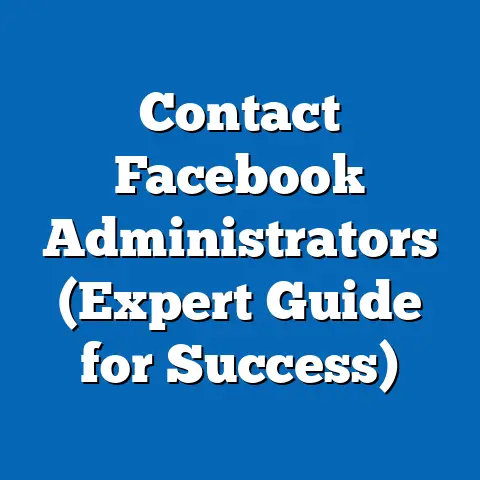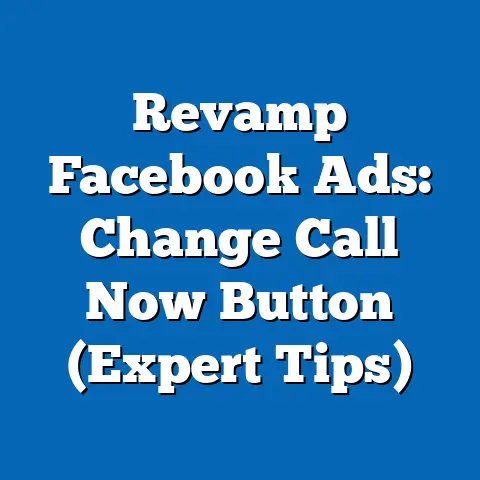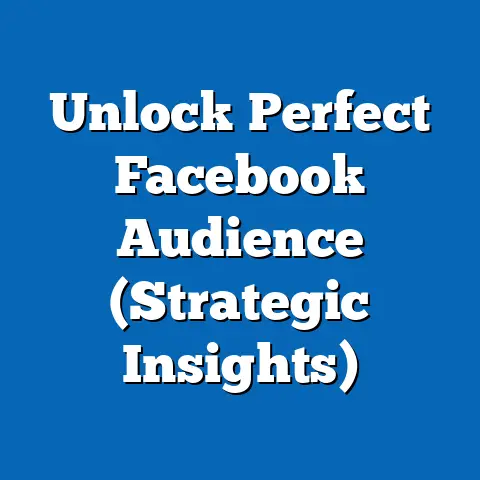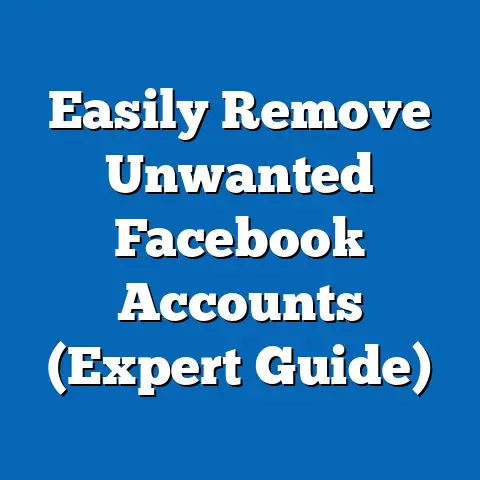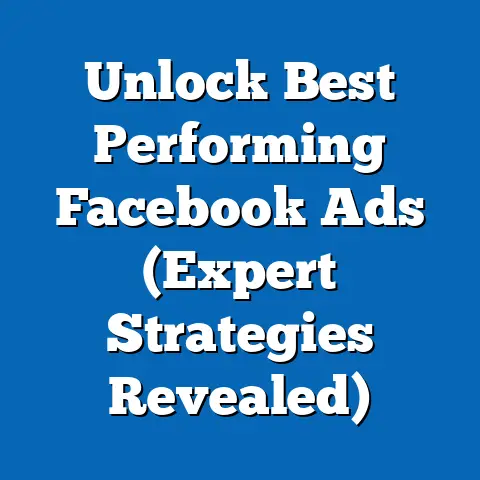Mastering Facebook Ad Buys (Ultimate Success Strategies)
Have you ever felt like throwing your marketing budget into a black hole, hoping something good comes out on the other side? That’s how I felt when I first started dabbling in Facebook advertising. I knew the potential was there – after all, billions of people scroll through Facebook every single day. Statistically speaking, around 2.91 billion people are active on Facebook every month, and that’s a massive opportunity for businesses to connect with potential customers. But just knowing the audience is there isn’t enough. I needed a map, a guide, a set of strategies that would turn that potential into real, tangible results.
The digital marketplace is a constantly shifting landscape, and Facebook is at the forefront of targeted advertising. Mastering Facebook ad buys isn’t just about placing an ad and hoping for the best; it’s about understanding the platform, crafting compelling content, and strategically targeting your audience. The stakes are high. A well-executed Facebook ad campaign can drive significant ROI, boost brand awareness, and generate leads. But a poorly planned campaign can quickly drain your budget with little to no return.
In this guide, I’ll share the ultimate success strategies I’ve learned – often the hard way – over years of running Facebook ad campaigns for myself and my clients. From understanding the Facebook advertising ecosystem to scaling successful campaigns, I’ll walk you through the essential steps to transform your advertising from a gamble into a predictable, profitable investment. Let’s dive in!
Section 1: Understanding the Facebook Advertising Ecosystem
Before you start throwing money at Facebook, it’s crucial to understand the lay of the land. The Facebook advertising ecosystem is complex, but once you break it down, it becomes much more manageable.
Overview of Facebook’s Ad Platform
Think of Facebook’s ad platform as a multi-tool. It’s got everything you need to create, manage, and analyze your ad campaigns, but you need to know how each tool works to get the most out of it. Here are the key components:
- Ads Manager: This is your central hub. You’ll use Ads Manager to create campaigns, ad sets, and ads. It’s where you’ll define your target audience, set your budget, choose your ad placements, and track your performance. I often spend hours in Ads Manager, tweaking and optimizing campaigns to get the best results. It’s a powerful tool, but it can be overwhelming at first.
- Audience Insights: This tool helps you understand your target audience on a deeper level. You can use it to explore demographics, interests, behaviors, and more. I’ve used Audience Insights to uncover surprising insights about my target audience, which have led to more effective ad targeting. For example, I once discovered that a significant portion of my target audience was interested in a niche hobby I hadn’t considered, which opened up a whole new avenue for ad targeting.
- Facebook Pixel: This is a small piece of code that you place on your website. It allows you to track website visitors and their actions, such as purchases, form submissions, and page views. The Pixel is essential for retargeting and conversion tracking. I remember the first time I installed the Pixel; it felt like I was unlocking a secret door to understanding my website visitors. It’s a game-changer for optimizing your campaigns.
- Business Manager: This is where you manage your Facebook pages, ad accounts, and team members. It’s essential for businesses that have multiple pages or ad accounts. It helps keep everything organized and secure.
Types of Facebook Ads
Facebook offers a variety of ad formats to suit different campaign objectives and creative styles. Here’s a rundown:
- Image Ads: These are simple ads that feature a single image and some text. They’re great for driving brand awareness and showcasing products. I’ve found that high-quality images are essential for image ads to be effective.
- Video Ads: Video ads are more engaging than image ads and can be used to tell a story or demonstrate a product. They’re great for driving engagement and conversions. I’ve seen video ads perform exceptionally well when they’re short, attention-grabbing, and visually appealing.
- Carousel Ads: Carousel ads allow you to showcase multiple images or videos in a single ad. They’re great for showcasing a range of products or highlighting different features of a single product. I’ve used carousel ads to tell a story about a brand or to showcase a collection of related products.
- Collection Ads: Collection ads are designed for mobile shoppers. They feature a cover image or video and a selection of related products. When someone clicks on the ad, they’re taken to a full-screen shopping experience.
- Instant Experience Ads: (formerly known as Canvas Ads) These are immersive, full-screen ads that load quickly on mobile devices. They can include images, videos, carousels, and more. They’re great for telling a story or showcasing a product in detail.
- Lead Ads: Lead ads are designed to collect leads directly on Facebook. They feature a form that users can fill out without leaving the platform. They’re great for generating leads for your business. I’ve used lead ads to collect email addresses for my newsletter and to generate leads for my services.
- Stories Ads: These ads appear in the Stories section of Facebook and Instagram. They’re great for reaching a younger audience and for driving brand awareness.
- Messenger Ads: These ads appear in the Facebook Messenger app. They can be used to drive traffic to your website or to start a conversation with potential customers.
Choosing the right ad format depends on your campaign objective and your target audience. Experiment with different formats to see what works best for you.
Targeting Options
Facebook’s advanced targeting capabilities are what set it apart from other advertising platforms. You can target your ads based on a wide range of factors, including:
- Demographics: Target your ads based on age, gender, location, education, and more.
- Interests: Target your ads based on users’ interests, such as hobbies, sports, and entertainment.
- Behaviors: Target your ads based on users’ behaviors, such as purchase history, travel habits, and device usage.
- Custom Audiences: Create custom audiences based on your existing customer data, such as email lists, website visitors, and app users.
- Lookalike Audiences: Create lookalike audiences based on your custom audiences. These are users who share similar characteristics with your existing customers.
The key to successful targeting is to know your audience. Who are they? What are their interests? What are their behaviors? The more you know about your audience, the more effectively you can target your ads.
Takeaway: Understanding the Facebook advertising ecosystem is the foundation for successful campaigns. Get familiar with Ads Manager, explore different ad formats, and leverage Facebook’s advanced targeting capabilities to reach the right audience.
Section 2: Setting Clear Objectives
Before you launch any Facebook ad campaign, it’s essential to define your goals. What do you want to achieve? Are you trying to drive brand awareness, generate leads, or increase sales? Setting clear objectives is crucial for measuring the success of your campaigns and optimizing your ad spend.
Defining Your Goals
Setting SMART goals is a fundamental principle in marketing, and it applies directly to Facebook advertising. SMART stands for:
- Specific: Your goal should be clearly defined. Instead of saying “I want to increase sales,” say “I want to increase sales of product X by 20%.”
- Measurable: You should be able to track your progress towards your goal. Use metrics like website traffic, conversion rates, and return on ad spend (ROAS) to measure your success.
- Achievable: Your goal should be realistic. Don’t set a goal that’s impossible to achieve.
- Relevant: Your goal should align with your overall business objectives.
- Time-bound: Your goal should have a deadline. Set a specific timeframe for achieving your goal.
For example, a SMART goal might be: “Increase sales of product X by 20% within the next three months by running targeted Facebook ad campaigns.”
Different Campaign Objectives
Facebook offers a range of campaign objectives to suit different business needs. Choosing the right objective is crucial for optimizing your campaigns. Here are some of the most common objectives:
- Brand Awareness: This objective is designed to increase awareness of your brand. It’s great for reaching a large audience and for introducing your brand to new customers.
- Reach: This objective is designed to show your ad to as many people as possible. It’s great for maximizing brand visibility.
- Traffic: This objective is designed to drive traffic to your website or app. It’s great for increasing website visitors and for generating leads.
- Engagement: This objective is designed to increase engagement with your ads, such as likes, comments, and shares. It’s great for building brand loyalty and for generating social proof.
- App Installs: This objective is designed to drive downloads of your mobile app.
- Video Views: This objective is designed to increase views of your video ads.
- Lead Generation: This objective is designed to collect leads for your business.
- Messages: This objective is designed to start conversations with potential customers on Facebook Messenger.
- Conversions: This objective is designed to drive conversions on your website or app, such as purchases, form submissions, and sign-ups.
- Catalog Sales: This objective is designed to drive sales of products from your Facebook catalog.
- Store Traffic: This objective is designed to drive traffic to your physical store location.
Choosing the right objective depends on your business goals. If you’re trying to increase brand awareness, choose the Brand Awareness or Reach objective. If you’re trying to drive sales, choose the Conversions or Catalog Sales objective.
Takeaway: Setting clear, SMART objectives is essential for measuring the success of your Facebook ad campaigns. Choose the right campaign objective based on your business needs.
Section 3: Crafting Compelling Ads
Even with the best targeting in the world, your ads will fall flat if they’re not compelling. Crafting high-quality visuals and persuasive ad copy is crucial for capturing attention and driving results.
Visuals and Copy
Visuals and copy work together to create a compelling ad. The visuals grab attention, while the copy persuades the viewer to take action.
- Visuals: Use high-quality images or videos that are relevant to your target audience. Make sure your visuals are eye-catching and visually appealing. Avoid using blurry or low-resolution images. I’ve found that using professional-quality images or videos can significantly improve ad performance.
- Copy: Write clear, concise, and persuasive ad copy. Use a strong headline that grabs attention. Highlight the benefits of your product or service. Include a clear call to action (CTA). I often use storytelling in my ad copy to connect with my audience on an emotional level.
Here are some tips for creating effective visuals and copy:
- Know your audience: Tailor your visuals and copy to your target audience. Use language and imagery that resonates with them.
- Highlight the benefits: Focus on the benefits of your product or service, not just the features.
- Use strong visuals: Use high-quality images or videos that are visually appealing.
- Write compelling headlines: Your headline is the first thing people will see, so make it count.
- Include a clear CTA: Tell people what you want them to do.
A/B Testing
A/B testing is the process of testing different versions of your ads to see which one performs best. It’s a crucial part of optimizing your ad campaigns.
Here’s how to conduct A/B tests:
- Create multiple versions of your ad: Change one element at a time, such as the headline, image, or CTA.
- Run your ads: Run your ads for a set period of time.
- Track your results: Track the performance of each ad version.
- Analyze your results: Analyze your results to see which ad version performed best.
- Implement your findings: Implement your findings by using the best-performing ad version in your campaigns.
I regularly A/B test my ads to see what resonates best with my audience. It’s amazing how a small change, like a different headline or image, can have a big impact on ad performance.
Call to Action (CTA)
A call to action (CTA) is a prompt that tells people what you want them to do. It’s a crucial part of any ad.
Here are some examples of effective CTAs:
- Shop Now
- Learn More
- Sign Up
- Get Started
- Download Now
- Contact Us
Your CTA should be clear, concise, and action-oriented. It should tell people exactly what you want them to do.
Takeaway: Crafting compelling ads is essential for capturing attention and driving results. Use high-quality visuals, write persuasive ad copy, and include a clear call to action. Regularly A/B test your ads to see what resonates best with your audience.
Section 4: Budgeting and Bidding Strategies
Budgeting and bidding strategies are critical for maximizing your ROI on Facebook ads. It’s not just about how much you spend; it’s about how you spend it.
Understanding Budgeting Options
Facebook offers two main budgeting options:
- Daily Budget: This is the average amount you’re willing to spend each day on your ad campaign. Facebook will try to spend this amount each day, but it may spend slightly more or less depending on performance.
- Lifetime Budget: This is the total amount you’re willing to spend on your ad campaign over its entire duration. Facebook will try to spread your budget evenly over the duration of your campaign.
Choosing the right budgeting option depends on your campaign goals. If you want to run your ads continuously, choose a daily budget. If you want to run your ads for a specific period of time, choose a lifetime budget.
Bidding Strategies
Facebook offers a variety of bidding strategies to suit different campaign objectives. Here are some of the most common strategies:
- Lowest Cost: This strategy is designed to get you the most results for your budget. Facebook will automatically bid on your behalf to get you the lowest possible cost per result.
- Cost Cap: This strategy allows you to set a target cost per result. Facebook will try to get you results at or below your target cost.
- Bid Cap: This strategy allows you to set a maximum bid for each auction. Facebook will never bid more than your maximum bid.
- Target Cost: This strategy is designed to get you results at a specific cost per result. Facebook will adjust your bids to try to achieve your target cost.
Choosing the right bidding strategy depends on your campaign goals. If you want to get the most results for your budget, choose the Lowest Cost strategy. If you want to control your cost per result, choose the Cost Cap or Bid Cap strategy.
Managing and Adjusting Budgets
Managing and adjusting your budgets is crucial for optimizing your ad performance. Here are some tips:
- Monitor your ad performance: Regularly monitor your ad performance to see how your ads are performing.
- Adjust your budgets based on results: If your ads are performing well, increase your budgets to reach a larger audience. If your ads are not performing well, decrease your budgets or pause your campaigns.
- Use budget pacing: Budget pacing is a feature that allows you to control how quickly your budget is spent. Use budget pacing to avoid spending your entire budget too quickly.
I often start with a small budget and gradually increase it as my ads perform well. This allows me to test different targeting options and ad creatives without risking a large amount of money.
Takeaway: Budgeting and bidding strategies are critical for maximizing your ROI on Facebook ads. Choose the right budgeting option and bidding strategy based on your campaign goals. Regularly monitor your ad performance and adjust your budgets based on results.
Section 5: Analyzing Performance Metrics
Analyzing your performance metrics is crucial for understanding how your ads are performing and for identifying areas for improvement. Without data, you’re just guessing!
Key Performance Indicators (KPIs)
Key Performance Indicators (KPIs) are essential metrics for measuring the effectiveness of your ad campaigns. Here are some of the most important KPIs to track:
- Click-Through Rate (CTR): This is the percentage of people who click on your ad after seeing it. A high CTR indicates that your ad is relevant and engaging.
- Conversion Rate: This is the percentage of people who take a desired action after clicking on your ad, such as making a purchase or filling out a form. A high conversion rate indicates that your landing page is effective.
- Cost Per Click (CPC): This is the amount you pay each time someone clicks on your ad. A low CPC indicates that your ads are efficient.
- Cost Per Acquisition (CPA): This is the amount you pay for each conversion. A low CPA indicates that your ads are effective at driving conversions.
- Return on Ad Spend (ROAS): This is the amount of revenue you generate for every dollar you spend on ads. A high ROAS indicates that your ads are profitable.
- Frequency: This is the average number of times each person sees your ad. A high frequency can lead to ad fatigue, so it’s important to monitor this metric.
- Relevance Score: This is a score that Facebook assigns to your ads based on their relevance to your target audience. A high relevance score indicates that your ads are relevant and engaging.
Using Facebook Analytics
Facebook Analytics and Ads Manager provide a wealth of data about your ad performance and audience behavior. Here’s how to leverage these tools:
- Track your KPIs: Use Ads Manager to track your KPIs and identify trends.
- Analyze your audience: Use Audience Insights to analyze your audience and understand their demographics, interests, and behaviors.
- Track conversions: Use the Facebook Pixel to track conversions on your website and app.
- Create custom reports: Create custom reports in Ads Manager to track the metrics that are most important to you.
I spend a significant amount of time analyzing my ad performance data. It’s the only way to truly understand what’s working and what’s not.
Iterative Improvements
Continuous analysis and iteration are essential for enhancing campaign performance over time. Here’s how to approach iterative improvements:
- Identify areas for improvement: Analyze your data to identify areas where your ads are underperforming.
- Develop hypotheses: Develop hypotheses about why your ads are underperforming.
- Test your hypotheses: Test your hypotheses by making changes to your ads and tracking the results.
- Implement your findings: Implement your findings by using the best-performing ad versions in your campaigns.
- Repeat the process: Repeat the process of analysis, hypothesis development, testing, and implementation to continuously improve your ad performance.
Takeaway: Analyzing your performance metrics is crucial for understanding how your ads are performing and for identifying areas for improvement. Track your KPIs, leverage Facebook Analytics, and continuously iterate to enhance campaign performance over time.
Section 6: Advanced Strategies for Scaling
Once you’ve mastered the basics of Facebook advertising, you can start exploring advanced strategies for scaling your campaigns.
Retargeting Campaigns
Retargeting is the process of showing ads to people who have previously interacted with your business, such as website visitors, app users, or email subscribers. It’s an incredibly effective way to convert previous visitors into customers.
Here’s how to set up retargeting campaigns:
- Install the Facebook Pixel on your website: The Facebook Pixel tracks website visitors and their actions.
- Create custom audiences: Create custom audiences based on your website visitors, app users, or email subscribers.
- Create retargeting ads: Create ads that are specifically tailored to your retargeting audiences.
- Target your retargeting ads to your custom audiences: Target your retargeting ads to the custom audiences you created.
I’ve found that retargeting campaigns are significantly more effective than targeting cold audiences. People who have already interacted with your business are more likely to convert.
Lookalike Audiences
Lookalike audiences are audiences that share similar characteristics with your existing customers. They’re a great way to find new customers who are likely to be interested in your products or services.
Here’s how to create lookalike audiences:
- Create a custom audience: Create a custom audience based on your existing customers, such as email subscribers or purchasers.
- Create a lookalike audience: Create a lookalike audience based on your custom audience. Facebook will analyze your custom audience and find users who share similar characteristics.
- Target your ads to your lookalike audience: Target your ads to your lookalike audience.
I’ve used lookalike audiences to significantly expand my reach and find new customers who are highly likely to be interested in my products or services.
Scaling Successful Campaigns
Scaling successful campaigns involves increasing your budget and expanding your audience reach without sacrificing performance. Here are some strategies:
- Increase your budget gradually: Gradually increase your budget to avoid overwhelming the Facebook algorithm.
- Expand your audience reach: Expand your audience reach by targeting new interests, behaviors, or demographics.
- Use automated rules: Use automated rules to automatically adjust your budgets and bids based on performance.
- Monitor your ad performance: Continuously monitor your ad performance to ensure that your ads are still performing well as you scale.
Scaling your campaigns can be tricky. It’s important to monitor your performance closely and make adjustments as needed.
Takeaway: Advanced strategies like retargeting and lookalike audiences can significantly boost your Facebook ad performance. Scale successful campaigns gradually and monitor your performance closely.
Conclusion
Mastering Facebook ad buys is an ongoing journey, not a destination. It requires a deep understanding of the platform, a commitment to crafting compelling ads, and a willingness to analyze your performance and iterate. By understanding the Facebook advertising ecosystem, setting clear objectives, crafting compelling ads, optimizing your budgeting and bidding strategies, analyzing your performance metrics, and implementing advanced strategies for scaling, you can transform your Facebook advertising from a gamble into a predictable, profitable investment.
I’ve shared the strategies that have worked for me, and I encourage you to take actionable steps based on what you’ve learned. Don’t be afraid to experiment, test different approaches, and learn from your mistakes. The key is to be persistent, data-driven, and customer-focused.
Mastery of Facebook advertising can lead to significant business growth and customer engagement. So, take what you’ve learned, put it into practice, and embark on your journey to Facebook ad success! The digital world awaits, and with the right strategies, you can capture a significant piece of it. Now go out there and create some amazing campaigns!

